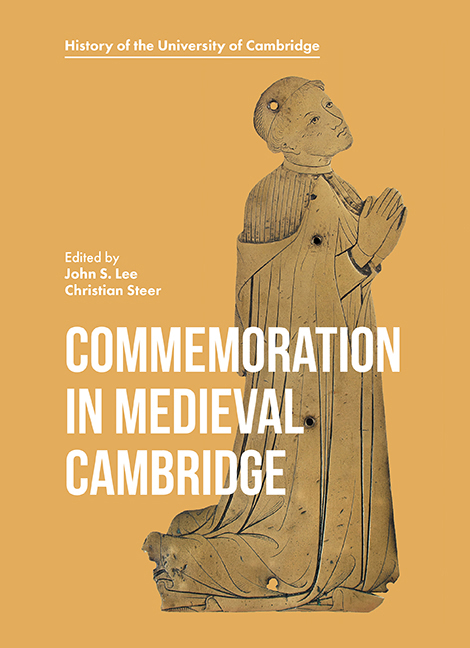Book contents
- Frontmatter
- Contents
- List of Illustrations
- Acknowledgements
- List of Contributors
- Abbreviations
- Introduction: In Fellowship with the Dead
- 1 Monuments and Memory: A University Town in Late Medieval England
- 2 The Commemoration of the Living and the Dead at the Friars Minor of Cambridge
- 3 The City of London and the Founding of the Guild of Corpus Christi
- 4 Patrons and Benefactors: The Masters of Trinity Hall in the Later Middle Ages
- 5 A Comparison of Academical and Legal Costume on Memorial Brasses
- 6 Commemoration at a Royal College
- 7 Cambridge Commemorations of Lady Margaret Beaufort's Household
- 8 ‘The Stones are all disrobed’: Reasons for the Presence and Absence of Monumental Brasses in Cambridge
- Bibliography
- Index
1 - Monuments and Memory: A University Town in Late Medieval England
Published online by Cambridge University Press: 25 October 2019
- Frontmatter
- Contents
- List of Illustrations
- Acknowledgements
- List of Contributors
- Abbreviations
- Introduction: In Fellowship with the Dead
- 1 Monuments and Memory: A University Town in Late Medieval England
- 2 The Commemoration of the Living and the Dead at the Friars Minor of Cambridge
- 3 The City of London and the Founding of the Guild of Corpus Christi
- 4 Patrons and Benefactors: The Masters of Trinity Hall in the Later Middle Ages
- 5 A Comparison of Academical and Legal Costume on Memorial Brasses
- 6 Commemoration at a Royal College
- 7 Cambridge Commemorations of Lady Margaret Beaufort's Household
- 8 ‘The Stones are all disrobed’: Reasons for the Presence and Absence of Monumental Brasses in Cambridge
- Bibliography
- Index
Summary
Commemoration can take the form of an action – a calling to remembrance, such as through prayer, or the form of an object – such as a memorial. Many studies of late medieval commemoration have tended to examine the latter, exploring particular monuments in particular contexts, mostly in churches and cathedrals, as well as considering different workshops, styles and patrons. They have focused on the product of commemoration. Most have taken a traditional approach to this subject, simply discussing the tomb, or the window, or the chantry without reflecting on the overall message. There were, however, a myriad of different commemorative enterprises available. The role of the monument in the context of remembrance, the benefactor, charity and prayer is here explored within the university town of Cambridge. Studies of towns, such as Bristol, are well known and in recent years there has been a revived interest in urban commemoration which has ‘opened up’ ideas on the bigger picture and how intercessory prayer dovetailed with investment in church building, most particularly the monument, to achieve salvation. New material on Boston, Coventry and York has revealed how urban elites and visitors sought appropriate commemorations for themselves and their families through a variety of differing and inter-connected strategies, while in London Christian Steer's study of St. James Garlickhithe has pieced together parts of the ‘commemoration jigsaw’ within this particular city parish, in which different forms of commemoration served the interests of the living and the dead. Individual monuments, too, are now receiving fresh interpretations.
In medieval Cambridge, the range of religious institutions to which benefactors could make gifts and entrust their commemoration expanded significantly. A burgess living in the town shortly after 1200 could choose to make a benefaction to one of sixteen parish churches, to either religious house (or both), or to one of the two hospitals. By 1300, Cambridge residents could also select one (or more) of the six houses of mendicant friars, or another religious house or hospital, as possible recipients. By 1400, wealthy Cambridge citizens could also choose one of many guilds or several academic colleges to provide their intercessory services. Patterns of benefaction among medieval townspeople generally followed these trends, with new institutions commonly becoming the chief objects of attention. The town was distinctive in having the presence of an academic community which grew in size and wealth during the later Middle Ages.
- Type
- Chapter
- Information
- Commemoration in Medieval Cambridge , pp. 10 - 33Publisher: Boydell & BrewerPrint publication year: 2018

